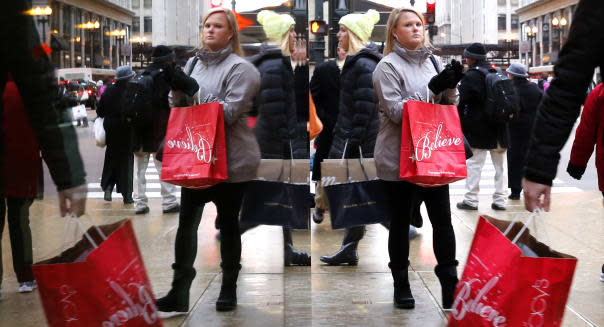Market Wrap: Record Highs for Dow, S&P 500, Russell 2000

By Ryan Vlastelica
NEW YORK -- U.S. stocks ended higher on Friday, with both the Dow (^DJI) and S&P 500 (^GPSC)closing at records in a broad rally, though trading was light with many market participants still out for the Christmas holiday. The Russell 2000 (^RUT) climbed 8.42 points, or 0.7 percent, to 1,215.21. That's an increase of 0.5 percent from the Russell's previous all-time high on March 4.
Major indexes closed out their second straight weekly gain, continuing an advance that has lifted the S&P 5.9 percent in seven sessions. The benchmark index hit its 52nd record close of the year on Friday, the most since 1995 and the fourth-best annual record ever, while the Dow rose for a seventh straight day, its longest streak since March 2013.
"The overall trend remains higher, but we're reaching a point where we're overbought. Six percent since last Tuesday is such a strong move in such a short period of time, even if bulls have the upper hand in the longer term," said Adam Sarhan, chief executive of Sarhan Capital in New York.
investors have been encouraged by signs of a strengthening U.S. economy, which the government estimates grew in the July-September quarter at the fastest pace in 11 years. Consumer spending and personal incomes have been rising. The economy has been creating more jobs. The markets also have history on their side. December is typically the best month of the year for stocks, while January is the second-best.
Utility Sector Is the Strongest
The day's gains were broad, with eight of the S&P 500's 10 primary sectors ending up on the day and no sector ending more than 0.1 percent lower. The utility sector was the day's strongest, up 1.2 percent, while health care rose 0.8 percent.
Health care stocks were boosted by biotechs, which jumped 2.3 percent. While the Nasdaq biotech index was one of the day's strongest sectors, it fell 3.2 percent in a week marked by heavy volatility. Celgene (CELG) rose 3.4 percent to $113.35 as the S&P 500's biggest percentage gainer, followed by Regeneron Pharmaceuticals (REGN), up 3.3 percent to $413.48.
The Dow Jones industrial average rose 23.5 points, or 0.13 percent, to 18,053.71, the S&P 500 gained 6.89 points, or 0.33 percent, to 2,088.77 and the Nasdaq Composite (^IXIC) added 33.39 points, or 0.7 percent, to 4,806.86. For the week, the Dow rose 1.4 percent, the S&P rose 0.9 percent and the Nasdaq rose 0.9 percent. It was the ninth positive week in the past 10 for the Dow and S&P.
Out Shopping
The S&P Retail index rose 0.5 percent in the first trading session after Christmas. Among notable names, Best Buy (BBY) rose 0.6 percent to $39.14 while Macy's (M) dipped 0.3 percent to $64.05. Amazon.com (AMZN) rose 2 percent to $309.18. "Things are looking positive since the shopping season coincided with a big drop in crude oil, which means lower gas prices," Sarhan said. "That translates to more disposable income, which could mean stronger retail sales."
Advancing issues outnumbered declining ones on the NYSE by 2,032 to 1,011, for a 2.01-to-1 ratio on the upside; on the Nasdaq, 1,792 issues rose and 934 fell for a 1.92-to-1 ratio favoring advancers. The benchmark S&P 500 index was posting 70 new 52-week highs and five new lows; the Nasdaq Composite was recording 133 new highs and 28 new lows. About 3.06 billion shares traded on all U.S. platforms, according to BATS exchange data, compared with the month-to-date average of 7.39 billion.
The Associated Press contributed to this post.
